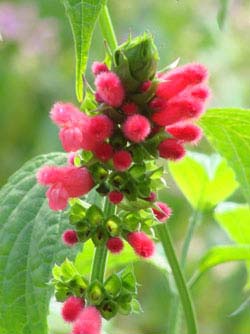Celebrity Salvias: Fuzzy, Fancy Salvia Oxyphora

A bright, cherry-licorice red, the large, fuzzy blossoms of Salvia oxyphora would make anyone stop and pay attention. Commonly known as Fuzzy Bolivian Sage or Bolivian Spearhead Sage, S. oxyphora has equally unusual foliage that fools the eye. At a distance, the plant’s lance-shaped leaves appear to be a smooth, glossy green. However, they are covered with tiny clear-to-white hairs. They’re also large -- growing up to 5 inches long and 2 inches wide at maturity -- and taper to long, sharp points.
It’s the extreme sharpness, or drip tips, of the leaves that likely give this plant its Latin appellation “oxyphora.” Roughly translated, “phora” means “bearing” and “oxy” means “sharpness.”
Maybe it was the plant’s combination of surprising color, texture and leaf shape that led to its first collection by a botanist.
Early Plant Exploration in Bolivia
On a southern hemisphere autumn day in April 1892, S. oxyphora grabbed the attention of 19th century plant explorer Otto Kuntze of Germany as he searched South America for species not yet introduced to horticulture.
Kuntze began work life as a business clerk and spent all his free time studying Berlin’s flora. At 25, he established a factory to refine volatile plant oils. His business was so successful that he was able to retire five years later and devote the rest of his life to botanical studies and exploration.
Writing in the April 2012 issue of Curtis’s Botanical Magazine, British botanists John Wood and Ray Harley note that Kuntze traveled by boat to South America and then by train and horseback from Argentina to Brazil. Along the way, Kuntze encountered S. oxyphora near the city of Cochabamba while venturing through the ferny jungle lands of Central Bolivia’s Los Yungas forest in the Andes Mountains.
Striving for Survival
Fuzzy Bolivian Sage is endemic to Bolivia, which means it occurs naturally in the wild nowhere else in the world. According to Wood and Harley, it isn’t prolific because it is generally unsuccessful at producing viable seeds.
Yet it grows in widely distributed patches on the lower altitude edges of Andean forests. Wood and Harley theorize that it may have been more abundant in the past. They speculate that “the hummingbird that used to pollinate it is now rare or extinct” and suggest monitoring of the “vulnerable” wild stands.
Luckily, it is easy to propagate the shrubby S. oxyphora from cuttings. This may be why Wood and Harley saw it cultivated in Bolivian home gardens although they never found it in the country’s commercial nurseries.
If a traveler to Bolivia does see S. oxyphora in the wild, this rhizomatous, mat-forming perennial most likely will be in open, disturbed ground -- the kind that has been farmed, logged or otherwise altered – at altitudes from about 1,000 to 6,500 feet. This indicates a certain kind of toughness although the species doesn't tolerate frost.
Also, unless visiting Bolivia during the southern hemisphere’s winter, our imaginary traveler has a good chance of seeing the plant in flower, because bloom time for S. oxyphora stretches from spring through fall.
Growing Fuzzy Bolivian Sage and the Warm Fuzzies
In America, S. oxyphora grows well in USDA Zones 7 to 9, but winter mulching is a good idea in the coldest part of this range. It needs full sun to partial shade and loamy, fertile, well-drained soil to reach about 36 to 48 inches tall and 36 inches wide - more in perfect growing conditions.
Although Fuzzy Bolivian Sage starts growing slowly, it takes off when weather gets warmer. Pinching its tips to encourage branching also discourages brittle growth that can break stems in heavy wind. Select a setting offering protection from wind is also a good idea.
Regular watering is sufficient. However, this sage loves moisture. It is a good solution for partially shady, moist areas of the yard. It is attractive in perennial borders, patio containers, cut flower beds and woodland gardens. For close-up views, use it to edge a walkway.
Be aware that you might get a case of the warm fuzzies when you plant Fuzzy Bolivian Sage. Wherever you plant it, hummingbirds are likely to find it. They love red and the rich nectar inside the tubular flowers that are just right for their beaks. Providing wildlife habitat and protecting vulnerable species is gratifying. Don’t hesitate to write or call us if you have any questions; it’s gratifying to be helpful.

Comments
There are no comments yet.